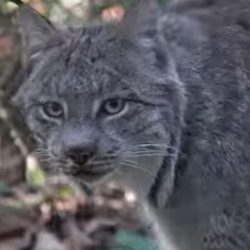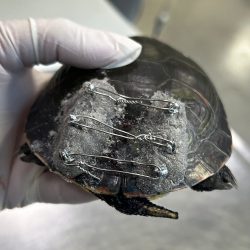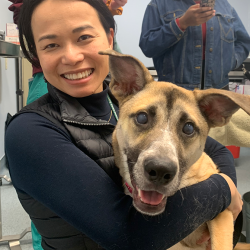Belle, a beefalo, was born on Saturday, August 5, 2017 at Old Hickory Beefalo Farm in the usual way—out in the pasture—as a late summer calf. Her dam, Mirabelle, is the matriarch of the Jackson family's beefalo herd.
Beefalo is a breed of cattle that contains between 18.75 and 37.5 percent bison genetics. Beefalo that contain 37.5 percent or 3/8 bison genetics are called full-blood beefalos. Her dam, Mirabelle, and sire, Red Dagger, are both full-blood beefalo, which makes Belle a full-blood or 3/8 bison.
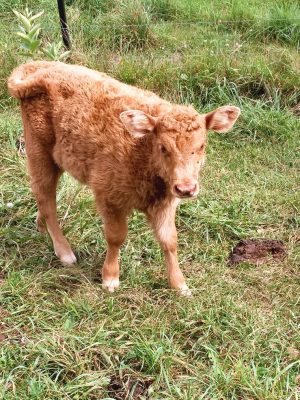
As a calf, Belle was always quiet, calm, and inquisitive; she remains this way as a heifer, but with the addition of her traditionally ladylike personality and long, striking eyelashes, she also can be described as dainty. “She always came up to me in the pasture to see what I was doing, but she was shy about it,” says Dr. Thad Jackson, Belle’s owner. “She would take a few steps toward me, but never came close enough to sniff my hand or for me to touch her; but this past November, all that changed.”
On Thursday, November 2, Jackson was feeding round bales of hay to his beefalo herd at sunset, as he routinely does. Eager to get a bite of hay, the adult cows were surrounding the tractor that Jackson was standing on. To avoid the adult cows, Belle jumped into the round bale feeder. “As I started to dump the round bale of hay into the feeder, I noticed that Belle was inside of it,” says Jackson. “By the time I noticed, the round bale had already started to slide off the bale spear, into the feeder, and landed on top of Belle.”
With her head sticking out of the top of the feeder and the rest of her body crushed by it, Jackson quickly got off the tractor and tried to lift one end of the round bale up so Belle could get out. “I wasn’t strong enough. So, I got back on the tractor and used the bale spear to lift the bale partially up and that’s when Belle scrambled out,” says Jackson. “I was elated that she was alive.”
Startled, but free from the feeder, Belle didn’t move a muscle as Jackson approached her. “That was my first clue that she wasn’t okay,” says Jackson. It took only moments for him to notice there was a deformity in her left hind limb. From the feed ambush and being crushed by the hay feeder, to breaking her leg, Belle didn’t make a sound. “There was no mooing, grunting, and she didn’t seem to be distressed,” says Jackson. “She just looked at me with her big, brown eyelashes.”

“I knew that to help her, I would need to convince her mother, Mirabelle, that taking her calf down to the barn for further care was the right thing to do,” says Jackson, who knew that this would require reinforcements. “With my wife and son assisting me, we put the pallet forks on the tractor, grabbed an old, rubber, 100-gallon water trough, and headed back to the pasture. By means of some creative maneuvering, we were able to use a towel sling to secure Belle into the trough and slowly drive back to the barn, as her very upset and concerned mama circled the tractor the entire way.”
The sun had fallen, and the night was dark as Jackson and his family placed Belle and her Mama safely in a small pen outside of the barn. “We wrapped her left hind limb with vet-wrap above and below the fracture, attempting to provide some support to the joint and maintain alignment,” says Jackson. “Belle kept wanting to lie on her side, which I knew was not ideal and would increase her risk of bloat, so we used a few small square bales to prop her upright with her front legs tucked underneath her for the night.”
Jackson awoke at daylight the next morning to check on Belle. He was pleased to see that she was still alive and nursing on her mama, but still very concerned about her left hind limb. “I called our local veterinarian, and he suggested that if I wanted to try and save Belle, I needed to call the MSU Veterinary Medical Center,” says Jackson.
“I previously had a very positive experience at MSU when I brought our family’s milk cow, Minnie Moo, to the Hospital when we discovered that she had developed a cancer in her eye. Although she was not able to be cured, we were treated with professionalism and kindness.”
So, Jackson called the Hospital and spoke with Dr. Jose Casillas, resident for the Hospital's Large Animal Clinic, and explained the situation, and that the Jackson family would soon be arriving with Belle.
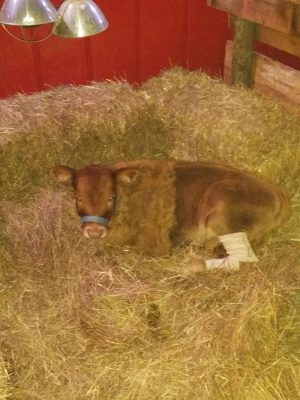
“Upon our arrival, I was impressed with the friendliness of all the staff,” says Jackson. The Jacksons unloaded Belle and were greeted by Casillas and Dr. Ann Rashmir, clinician for the Hospital's Large Animal Clinic, and Megan Bowen, licensed veterinary technician for the Hospital's Large Animal Clinic.
After conducting an Emergency Room triage exam, the clinical team took radiographs of Belle’s hind limbs. The tibia radiographs confirmed a long, oblique, cranially displaced fracture of the mid-to-distal left tibia. Amazingly, no other major injuries resulted from having a 900 lb. bale of hay dropped on top of her.
Post-diagnosis, Rashmir and Casillas explained treatment options for Belle. The best option, that would allow for complete recovery and opportunity to grow up to be a normal cow, was for Belle to undergo a surgical repair surgery performed by Dr. Loïc M. Déjardin, head of Orthopedic Surgery for the Hospital.
As luck would have it, Déjardin was available and came to the clinic to evaluate Belle that afternoon. After discussing cost and speaking with his wife, Jackson decided to proceed with the surgery.
Déjardin repaired the tibia fracture with an interlocking nail and cerclage wire. Though the procedure took a few hours longer than anticipated due to the complex nature of the fracture, the surgery was successful, and Belle recovered from anesthesia without difficulty. “Casillas personally called me at midnight to let me know Belle was doing well, which was very much appreciated,” says Jackson. “I also received an update on Belle’s progress from either Casillas or Rashmir daily.”
Our experience with MSU was excellent.
The Jacksons picked Belle up from the Hospital four days after her surgery and brought her back home. She was able to walk and get up and down on her own but stayed in a stall by herself for the first week while the Jacksons kept her incision clean and administered antibiotics. “We transitioned her to bucket feeding milk from our goat herd, and she was fed a high-quality hay and haylage (a type of feed for livestock that’s made from grasses and legumes),” says Jackson. “Once she was stronger, we brought in another heifer calf that we were halter training to keep Belle company.”
Belle had her one-month follow up visit with Déjardin on Monday, December 4. Thanks to the rich goat’s milk, she gained 82 pounds since she was discharged from the Hospital in November. Repeat radiographs taken at this checkup demonstrated excellent alignment and healing in Belle’s left hind limb. To record her progress, Déjardin captured a video recording of her walking.
“We are very thankful to clinicians, Déjardin, Rashmir, and Casillas for their professional skill in treating Belle for her fractured tibia,” says Jackson. “Belle’s tibia fracture is unique, and the surgical repair performed demonstrates the innovation and commitment of the MSU clinicians and animal care teams to the highest quality of care.”
Belle is now seven months old and continues to thrive. “She has maintained her pleasant demeanor and will become our family’s next milk cow, says Jackson. “She is learning how to walk on a lead, follows simple commands, and enjoys being groomed.”
Belle told me to especially thank Megan Bowen, the veterinary technician who sat with Belle in the emergency room and petted her for two hours while we waited for her to go to the operating room
“Our experience with MSU was excellent,” says Jackson, who is most impressed by the entire team approach that started from the moment he spoke to the Hospital’s receptionists. “They knowledgeable, compassionate, and professional.”
The Jacksons would like to thank all the veterinary technicians who were involved with Belle’s care. “Belle told me to especially thank Megan Bowen, the veterinary technician who sat with Belle in the emergency room and petted her for two hours while we waited for her to go to the operating room,” says Jackson. MSU College of Veterinary Medicine students, Kathryn Zelma, DVM class of 2018 and Lauren Lauwers, DVM class of 2018, also are included in the individuals whom the Jacksons are thankful for, as they also cared for Belle while she was at the Hospital.
“MSU turned an awful accident that occurred on Thursday, November 22 into a rewarding experience for Belle and our family, and we are very grateful,” says Jackson.

